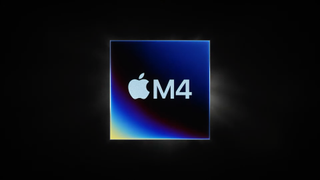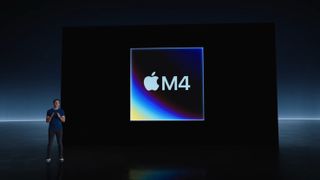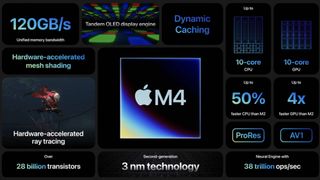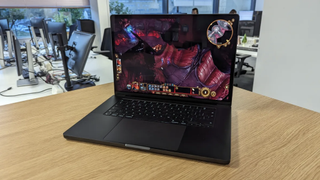Apple M4 chip: everything you need to know about Apple's latest silicon
The Apple M4 chip is the latest silicon for Macs and iPads, but how good is it?

The Apple M4 chip is Apple's latest silicon, powering its iPad Pro, new Mac mini, iMac, and MacBook Pro models, and it's one of the fastest processors going.
This system-on-a-chip (SoC) features second-generation 3nm core architecture, a faster neural engine, and more memory bandwidth for Apple Intelligence, among a few other tweaks over the Apple M3 chip.
We've had a good bit of time with the Apple M4 chip already thanks to the iPad Pro that launched in May 2024, but now with this SoC powering the latest Mac models, we're more excited than ever to see what one of the best processors around can do.
Apple M4 chip: Cut to the chase
- What is it? Apple's current generation of in-house silicon
- How much does it cost? It doesn't sell on its own but instead powers various Apple devices
- When can I get it? It is available in the iPad Pro, iMac, Mac mini, and 14-inch MacBook Pro.
Apple M4 chip: Latest news
- Apple has quietly given the M4 iMac some hidden upgrades – here are the ones you may have missed
- M4 MacBook Pro adds M4 Max power and promises 24 hours of battery life
- Apple's M4 Mac mini is the smallest Mac ever and, with a new M4 Pro option, possibly the most powerful too
Read more Apple M4 news...
- Apple launches new iMac with M4 chips, first Macs with Apple Intelligence
- M4 MacBook Pro, Mac mini, and iMac are reportedly on track for 2024 launch
- Keen for the MacBook Air M4? Good news – it might turn up earlier than we thought in 2025
- Some of Apple’s M4 Macs are already shipping ahead of rumored October launch
- Apple’s big Mac M4 reveal could happen in October, ahead of rumored on-sale date of November
- Apple’s M4 Macs spotted in testing – with a hint that entry-level MacBook Pro 14-inch could get the RAM upgrade everyone craves
- Apple M4 chip debuts in iPad Pro as Apple pulls further ahead of Microsoft and Intel
- The Mac Mini M4 is coming – and it could be the smallest Mac that Apple’s ever made
- Desperate for a MacBook Pro M4? Here’s some good news – another rumor points firmly to a launch later in 2024
- I ditched my laptop for an iPad Pro for a few weeks – here’s what I learned
- Apple's iPad Air 6 launches with a bigger 12.9-inch screen and MacBook-level chipset
- If Apple debuts the M4 chip in an iPad, it tells me it's losing faith in its MacBooks – but I won't be giving mine up
- Apple could be playing it smart by waiting for its M4 chips before releasing a new Mac mini
- Apple might start developing its own AI chips - here’s what that means for Mac lovers
- The first M4 Macs could land this year as Apple looks to make up ground in the AI race
- Apple M4 chips could debut early next year - if these professional predictors are correct
- Forget the new MacBook Airs – Apple might already be working on M4 MacBook Pros
Apple M4 chip: Release date

The Apple M4 chip was announced at the May 7, 2024, 'Let Loose' iPad event and shipped with iPad Pro devices on May 13, 2024.
It was announced for the new iMac (2024) on October 28, 2024, the new Mac mini on October 29, 2024, and the 14-inch MacBook Pro on October 30, 2024. All M4 Mac products will be available in-store on November 8, 2024.
Apple M4 chip: Specs

The Apple M4 is built on TSMC's 3nm process node, the same as the Apple M3 chip, though Apple does refer to it as a 'second-generation' chip, so it's more advanced than the Apple M3.
It features up to a 10-core CPU (4 performance cores and 6 efficiency cores) and a 10-core GPU, up from the 8-core CPU and 8-core GPU of the base M3 chip, and supports up to 38 trillion operations per second (TOPS) in its 16-core neural engine (Apple's version of an NPU).
Get the best Black Friday deals direct to your inbox, plus news, reviews, and more.
Sign up to be the first to know about unmissable Black Friday deals on top tech, plus get all your favorite TechRadar content.
It contains 28 billion transistors, up from 25 billion in the M3, and can support up to 128GB of unified memory.
Like the M3, the Apple M4 also has support for hardware-accelerated ray tracing, dynamic caching, and mesh shading. It also features dynamic caching, which improves the memory efficiency of GPU-intensive tasks.
The new M4 chip also introduces support for Tandem OLED displays, which use two OLED pixel layers together to create a single display that offers better efficiency and longevity than traditional OLED panels, as well as hardware-accelerated AV1 media support for the first time.
Apple M4: Performance

It's hard to compare the performance of the Apple M4 chip to the Apple M3 chip since the only device we've been able to test with an M4 is the iPad Pro, and comparing a laptop or desktop M3 to an M4 tablet isn't great. The benchmarks aren't very consistent, they will have different power profiles, as well as various underlying specs that can throw scores off one way or the other.
But we're going to do it anyway, at least until we get new Macs that will let us more directly compare specs across similar devices to isolate the M4's true performance.
| Header Cell - Column 0 | M4 | M3 | Performance increase |
|---|---|---|---|
| Geekbench 6 Single-Core | 3,700 | 3,082 | 20.1% |
| Geekbench 6 Multi-Core | 14,523 | 12,087 | 20.2% |
| CrossMark Overall | 1,915 | 1,888 | 1.4% |
| CrossMark Productivity | 1,771 | 1,747 | 1.4% |
| CrossMark Creative | 2,312 | 2,255 | 2.5% |
When it comes to raw synthetic performance, the Apple M4 in the iPad Pro 13-inch is substantially faster than the Apple M3 found in both MacBook Air models, Apple iMac, and MacBook Pro 14-inch.
Both single-core and multi-core performance clocks in about 20% faster on the M4 chip than on the M3, but when you drill down to actual day-to-day performance, the difference between the two is barely noticeable (at least according to CrossMark).
| Header Cell - Column 0 | M4 | M3 | Performance increase |
|---|---|---|---|
| 3DMark Wild Life Extreme | 8,289 | 7,866 | 5.4% |
| 3DMark Wild Life Extreme Unlimited | 8,529 | 8,306 | 2.7% |
| 3DMark Solar Bay | 14,333 | 12,554 | 14.2% |
| 3DMark Solar Bay Unlimited | 15,266 | 13,569 | 12.5% |
Basic GPU performance on the M4 chip is slightly improved over the M3, though not really enough that you'd notice. When you use ray-tracing, however, the difference becomes much more apparent, with the M4 getting around 13-14% faster performance over its predecessor.
| Header Cell - Column 0 | M4 | M3 | Performance increase |
|---|---|---|---|
| Geekbench AI Core ML: Full Precision | 3,280 | 2,474 | 32.6% |
| Geekbench AI Core ML: Half Precision | 18,817 | 13,994 | 34.5% |
| Geekbench AI Core ML: Quantized | 21,724 | 14,861 | 46.2% |
In terms of neural engine performance, the Apple M4 really pulls away, performing AI workloads up to 46% faster than the Apple M3.
This is going to be especially important in the months and years ahead as Apple invests more resources into Apple Intelligence, which is going to require a much better NPU than earlier M-series chips.

John (He/Him) is the Components Editor here at TechRadar and he is also a programmer, gamer, activist, and Brooklyn College alum currently living in Brooklyn, NY.
Named by the CTA as a CES 2020 Media Trailblazer for his science and technology reporting, John specializes in all areas of computer science, including industry news, hardware reviews, PC gaming, as well as general science writing and the social impact of the tech industry.
You can find him online on Threads @johnloeffler.
Currently playing: Baldur's Gate 3 (just like everyone else).
Most Popular



